The Genealogical Proof Standard tells us that we need to conduct reasonably exhaustive research in order for our work to be credible. If you’ve ever wondered just what constitutes “reasonable” (and if your family tree is up to snuff) my guest author Kate Eakman, professional genealogist at Legacy Tree Genealogists, has answers.
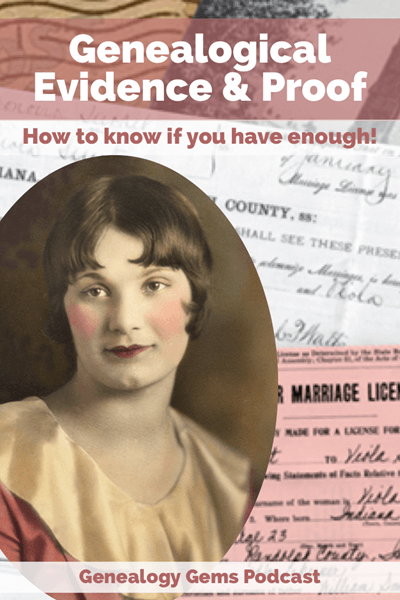
Professional Genealogist Kate Eakman explains evidence on the Genealogy Gems blog.
Genealogical Evidence: Have You Got What It Takes?
How do we know when we have compiled enough evidence to constitute proof?
Is a birth certificate or an autosomal DNA test result sufficient to declare this person is the child of that person?
Must we collect every record regarding an individual – the deeds, the tax lists, the newspaper clippings, the census reports – before we can declare a familial connection?
The Genealogical Proof Standard (GPS)
The Genealogy Proof Standard (GPS) directs us to perform reasonably exhaustive research, which requires that we identify and review all available records related to an individual.[1] This is being as thorough and accurate as possible and is a goal toward which we should all aspire in our genealogical research.
But, let’s be honest: most of us do not want to spend weeks or months (or even years) documenting one person before moving on to the next individual. We don’t want to know every detail of grandpa’s life before we turn to grandma.
We want to build a family tree which accurately provides us with the names of our ancestors so that we can identify our immigrant ancestor, or join a lineage society, or enjoy the satisfaction that comes from a balanced tree extending back a hundred years or more.
We want to be thorough and accurate, but we also want to make some progress. How do we balance the need for accuracy with the desire for results? How do we determine the necessary quality and quantity of evidence for our research?
Below are some guidelines to demonstrate how we can go about compiling the necessary information to say with confidence “this person is my ancestor.”
Genealogical Evidence Guidelines
1. One record/source is never enough.
Any one piece of data can say anything. A mother might lie on her child’s birth certificate for a number of reasons. A grieving spouse might not correctly recall the information for a husband or wife’s death certificate. There are typos and omissions and messy handwriting with which to contend. Even a lone DNA test is not sufficient evidence to prove a family connection.
We need multiple sources, and different kinds of sources, which corroborate the details of the others.

A single source is not enough. A marriage license does not guarantee that John and Griselda married. Photo courtesy https://newspapers.com.
A census report and autosomal DNA test results.
A deed and a will.
A birth certificate and an obituary.
Or, better still, a birth certificate, a census report, a deed, a will, an obituary, and autosomal DNA test results.
2. The more contemporary the source is to the person or event in question, the better.
Records of events made immediately after the event tend to be more accurate, and provide better details, than records created months or years later. As time passes, details become fuzzy, two events can be confused with each other, and our memories fade.
The passage of time between an event and the record of the event also allows for some revisionist history to creep in.
Here are some examples:
A birth year is adjusted to make someone appear older or younger in order to avoid the draft, enlist in the military, mask a dramatic age difference between spouses, or conceal an out-of-wedlock birth.
An obituary ignores the deceased’s first marriage because of some embarrassment associated with that marriage.
A census report enumerates everyone in the household as natives of Stepney, London, when they really were born in Stepney, and Hackney, and Whitechapel, which explains why the baptismal records can’t be found in Stepney.
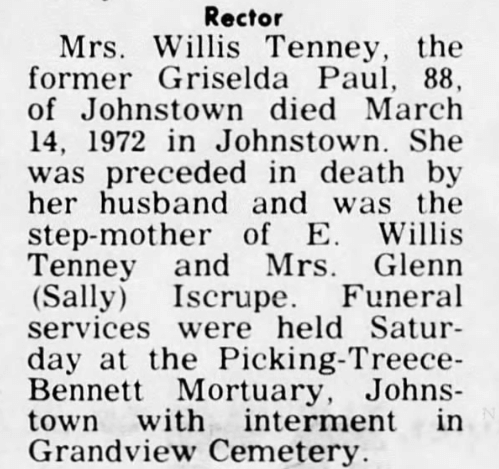
According to this obituary for Griselda, she was the widow of Willis Tenney, not John Wise. It appears Griselda and John did not marry after all. Photo courtesy https://newspapers.com.
According to this obituary for Griselda, she was the widow of Willis Tenney, not John Wise. It appears Griselda and John did not marry after all. Photo courtesy https://newspapers.com.
This is particularly true when it comes to autosomal DNA testing. My autosomal DNA is more useful for identifying my ancestors than is my son’s because I am one generation closer to those ancestors. This is the reason we encourage people to test the oldest members of their family first: their DNA has the potential to be the most useful simply because they are from an earlier generation (or two).
3. It is okay to make appropriate assumptions, but be careful!
In genealogical research we must sometimes make assumptions. When research theories are based on logical reasoning, it is perfectly acceptable to make those appropriate suppositions.
Determining which assumptions are appropriate can be simple: the two-year-old child enumerated in the home of a 90-year-old woman in the 1850 census can safely be eliminated as a biological child of that woman; the man born in 1745 could not have been buried in 1739; the person with whom I share 3150 cM of DNA is my sibling.
The challenge is to avoid making what seems like an appropriate assumption but is really based on faulty reasoning or bias. For instance, we presume that every child listed in a household in the 1860 U.S. Census is son or daughter of the two adults listed first. However, the household could include step-children, cousins, or individuals not even related to the family who were erroneously assigned the same surname.
Other inappropriate assumptions can include:
- the notion that a baby was born within a week of his baptismal date;
- a woman’s reported surname on her marriage certificate is her maiden name;
- there is only one person in any village, town, or city with the name of your ancestor;
- someone who shares 2000 cM of DNA with you must be your grandparent, aunt or uncle, niece or nephew, half sibling, or grandchild (they could be a ¾ sibling, the child of one of your parents and the sibling of the other parent).
4. All of the data from the various sources must correlate, and there can be no unresolved contradictions.
When the birth certificate says Richard was born in 1914, the 1938 newspaper article about his wedding reports Richard was 24 years old and the 1942 World War II Draft Registration card notes Richard’s date of birth occurred in 1914, we can confidently declare Richard was born in 1914.
If the wedding article declared the groom was 23 years old the contradiction could be explained by the time of year in which the wedding occurred – before or after Richard’s birthday.
But if his birth certificate reported a 1914 birth, and the newspaper article noted Richard was 32 years old, while the World War II Draft Registration listed his year of birth as 1920, we have some important contradictions. It is most likely the records are for three different men with the same name.
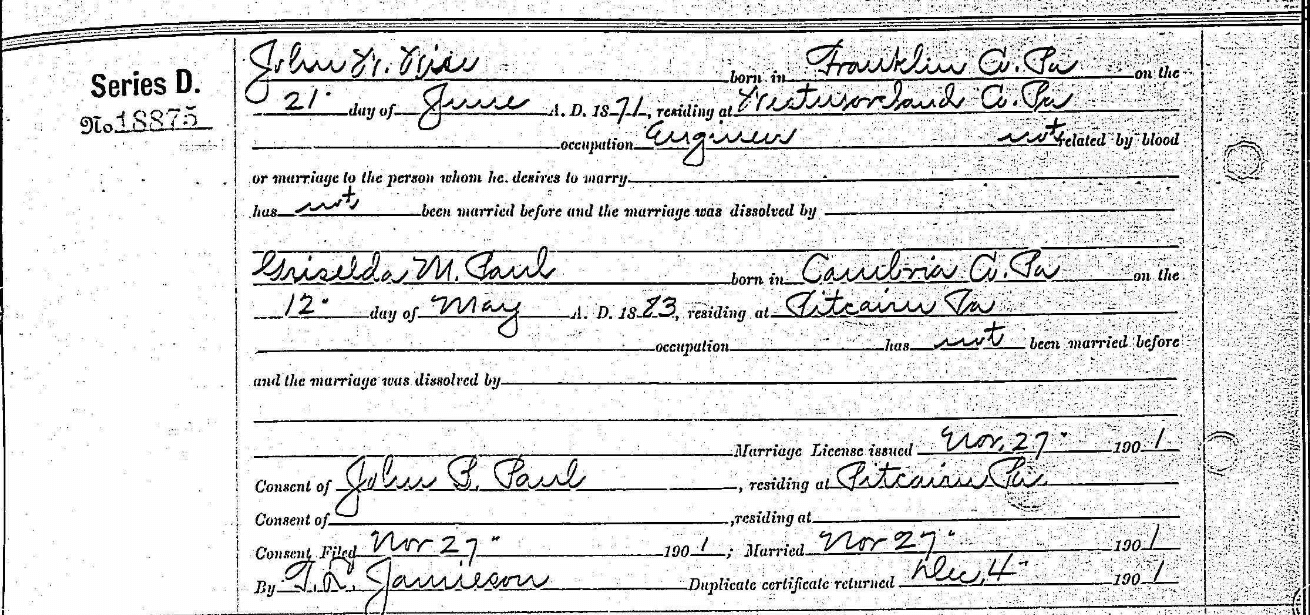
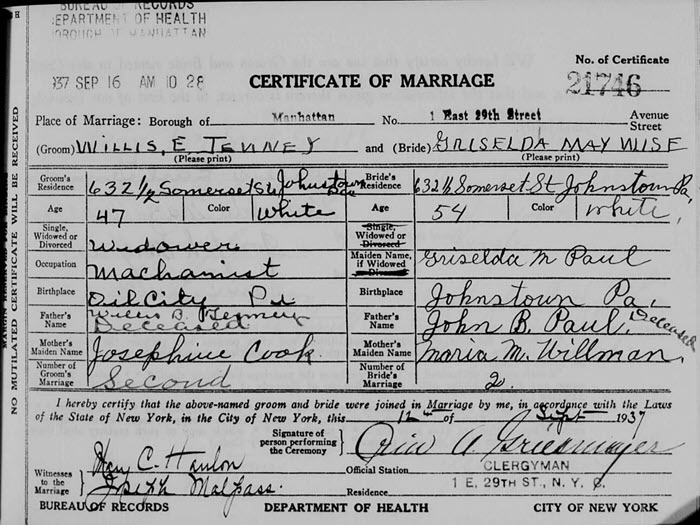
By collecting additional evidence, we finally learn that Griselda and John Wise did marry, and after his death Griselda married Willis Tenney. If we had collected only one of these four records we would not have had the most accurate information regarding Griselda Paul. Photos courtesy https://familysearch.org.
It’s important to remember that once we have accomplished that initial goal of building out our tree a few generations (or identifying our immigrant ancestor, or determining if we are related to that historical person) we can – and should – go back and collect other sources related to that person. This will result in uncovering a more complete story of their lives in the process.
As we can see from the four documents regarding Griselda Paul’s marriages, her story is much more than a simple list of birth, marriage, and death dates. As we identify, review, and analyze the other available sources, Griselda’s story will come alive with the facts and details we uncover.
A Fresh Set of Eyes on Your Genealogy Brick Wall
Sometimes the wrong evidence or assumptions can push us into a brick wall. A fresh set of expert eyes can help you identify the problem, and recommend the sources you need to pursue in order to compile trustworthy evidence.
If you are looking for some assistance in your genealogical research, Legacy Tree Genealogists can help. Our affordable ($100 USD) Genealogist-on-DemandTM Virtual Consultation service provides you with the opportunity for a 45 minute one-on-one discussion of your research with one of our expert genealogists. We can help guide you in evaluating evidence and determining research strategies to move forward with your research confidently.
About the Author: Kate Eckman
Legacy Tree guest blogger Kate Eakman grew up hearing Civil War stories at her father’s knee and fell in love with history and genealogy at an early age. With a master’s degree in history and over 20 years experience as a genealogist, Kate has worked her magic on hundreds of family trees and narratives.
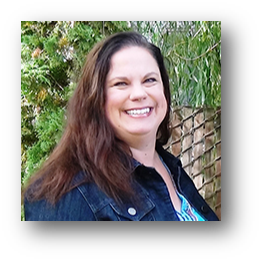
Professional Genealogists Kate Eakman
[1] “Genealogical Proof Standard (GPS),” Board for Certification of Genealogists, https://bcgcertification.org/ethics-standards, accessed March 2020.






Lately, a woman told me that 3 of any documents should be in agreement -but she was including Family Tree info from 3 different families – not documents of the sort you mentioned. Without seeing all sources -or media- within the tree, how can we know that those families had all agreed on the right person? It doesn’t seem entirely likely to me.
You’re right, we can’t depend on family tree info even from different people because they could all be copying and passing around information. We can take the information as clues, and then go out and find the records to back it up or disprove it.